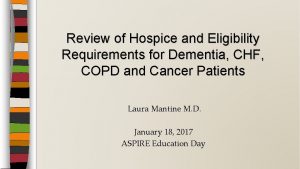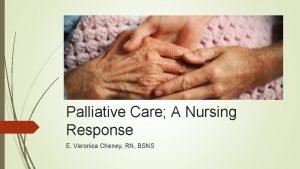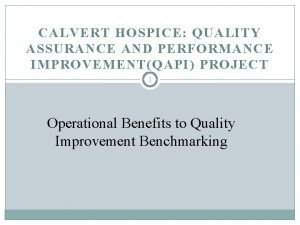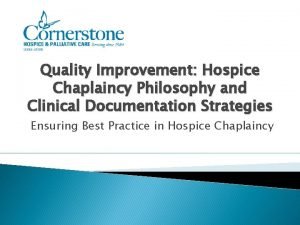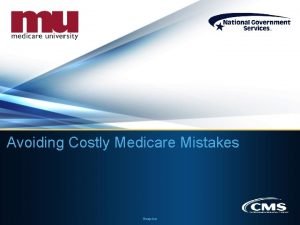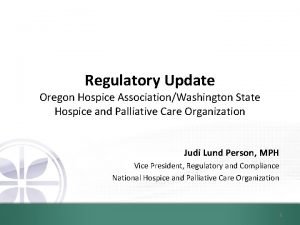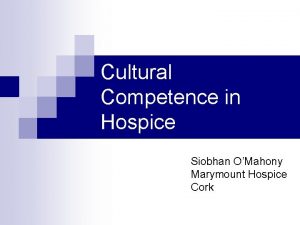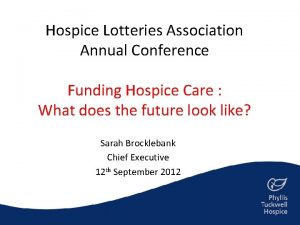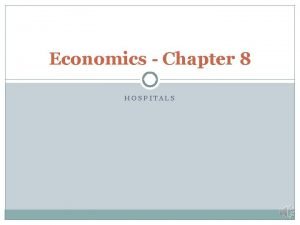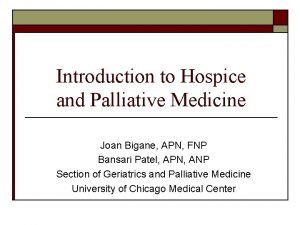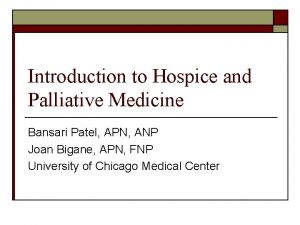Hospitals Introduction History of Hospitals Hospitals vs Hospice


























- Slides: 26

Hospitals

Introduction • History of Hospitals • Hospitals vs. Hospice

Hospital Ownership • Public vs Private • Profit or Non-Profit • Type of care (primary, secondary, tertiary, …) • Type of services (ASC…)


Number of Public Community Hospitals, 1990 -2007 Notes: Includes nonfederal (i. e. , state and local government), short-term general and specialty hospitals whose facilities are available to the public. Public community hospitals represent 23% of all community hospitals, and community hospitals represent about 85% of all hospitals. Federal hospitals, long term care hospitals, psychiatric hospitals, institutions for the mentally retarded, and alcoholism and other chemical dependency hospitals are not included. Source: American Hospital Association Annual Surveys: 1990 -1998 data from Hospital Statistics, 2002 , Table 1; 1999 -2007 data from AHA Annual Surveys, Copyright 2009 by Health Forum LLC, an affiliate of the American Hospital Association, at http: //www. ahaonlinestore. com.


Principle Agent Problems • Owners versus Managers

Market Structure • Monopolies • Monopolistically Competitive • Market Concentration – Herfindahl-Hirschman Index (sum of squared market shares measured in percentages) Monopoly = 10, 000 ie. 100^2 • >1, 400 subject to antitrust. • 5, 000 two equal market shares.


Effect of Competition on Prices • Until late 80 s more competition meant higher prices. Competing on quality? • Medical Arms Race • Payer Driven Competition? HMOs lower prices

Role of Government • Capital Assistance – Stimulus funds electronic records • Provision of Public Hospitals • Medicare and Medicaid

Government Regulations of Hospitals • Certificate of Need (CON) – Wisconsin (ended 2011) • Effects of CON on Nursing Homes



2004 Per Capita Hospital Expenses • • • Hospital Expense Per Capita Massachusetts $2, 357 North Dakota $2, 229 New York $2, 202 Missouri $2, 009 Maine $1, 936 Ohio $1, 932 West Virginia $1, 930 Rhode Island $1, 929 Pennsylvania $1, 925 • • • Delaware South Dakota Nebraska Minnesota Vermont Indiana Connecticut Michigan Iowa Wisconsin Illinois $1, 908 $1, 867 $1, 862 $1, 804 $1, 775 $1, 750 $1, 745 $1, 731 $1, 720 $1, 710 $1, 709 • Con states in bold

Hospitals and Medicare PPS • Prospective Payment System • http: //www. cms. hhs. gov/Prosp. Medicare. Fee. S vc. Pmt. Gen/

Price Discrimination • Forms of Price Discrimination • Cost Shifting

Role of Charity in Modern Hospitals • Hospital Altruism – Model of • Pure vs Impure – Evidence

Declining Demand for Inpatient Care

• http: //www. statehealthfacts. org/comparetabl e. jsp? ind=397&cat=8

Capacity We analyze admission and discharge decisions when hospitals become capacity constrained on high-demand days, and develop a test for discrimination that, under certain circumstances, does not require controls for differences across patient groups. On high-demand days, patients are discharged earlier than expected compared to those discharged on low-demand days. High demand creates no statistically significant differences in hospitals' admission behavior. Thus, hospitals appear to ration capacity by hastening discharges rather than by restricting admissions. We could not reject a null hypothesis of no discrimination against Medicaid patients in discharges. Copyright (c) 2008, RAND.




Hospitals’ Probability Of Offering Psychiatric Emergency Services, By Ownership Type, 1988 – 2000. Horwitz J R Health Aff 2005; 24: 790 -801 © 2005 by Project HOPE - The People-to-People Health Foundation, Inc.

Hospitals’ Probability Of Offering Open-Heart Surgery, By Ownership Type, 1988– 2000. Horwitz J R Health Aff 2005; 24: 790 -801 © 2005 by Project HOPE - The People-to-People Health Foundation, Inc.
 Pps scale hospice
Pps scale hospice Hospice forum danmark
Hospice forum danmark Fast score hospice
Fast score hospice Tarek mahdi md
Tarek mahdi md Palliative care vs hospice care
Palliative care vs hospice care Bluegrass hospice
Bluegrass hospice Menotti bassani hospice
Menotti bassani hospice Hospice face to face template
Hospice face to face template Pps scale
Pps scale Pps scale hospice
Pps scale hospice An attitude that is helpful in hospice work is
An attitude that is helpful in hospice work is Hospice secretions medication
Hospice secretions medication Hospice raggio di sole salemi
Hospice raggio di sole salemi Franciscan palliative care
Franciscan palliative care Hospice quality assurance
Hospice quality assurance The hospice lottery partnership
The hospice lottery partnership Hospice chaplain documentation examples
Hospice chaplain documentation examples Hospice marketing strategies
Hospice marketing strategies Hospice di abbiategrasso
Hospice di abbiategrasso Marymount hospice
Marymount hospice Macy catheter medication administration
Macy catheter medication administration Understanding hospice
Understanding hospice Casi hospice général
Casi hospice général Pepper report hospice
Pepper report hospice +hospice +local
+hospice +local Hospice codigoro
Hospice codigoro The hospice
The hospice


